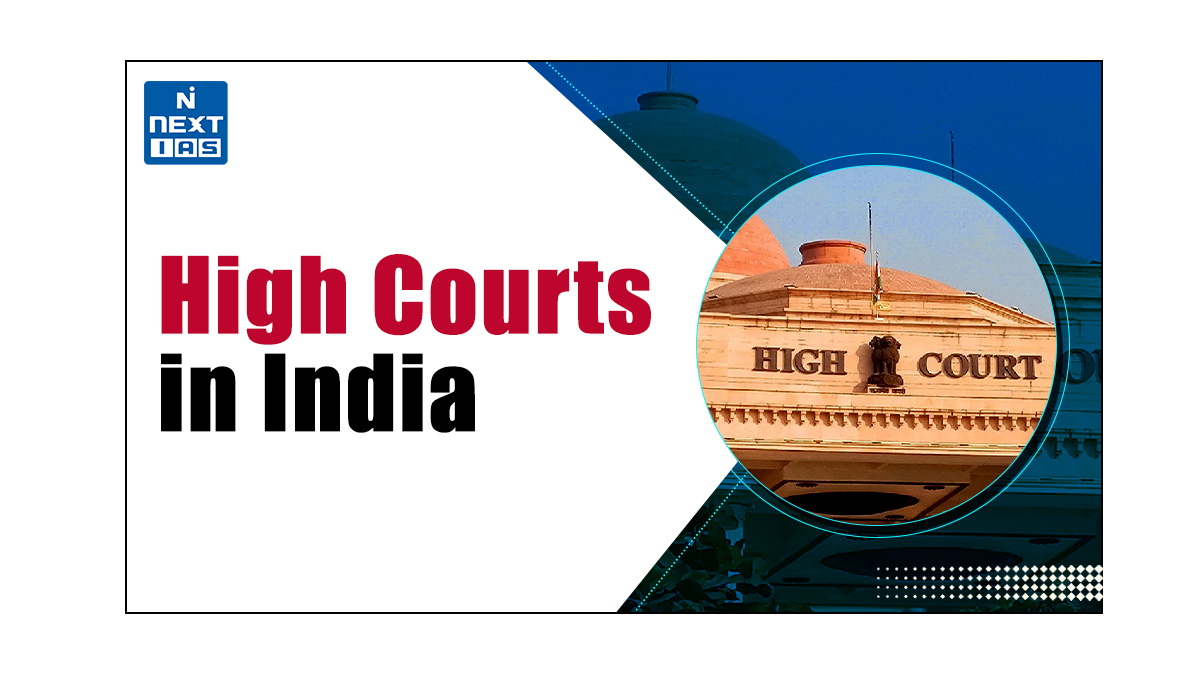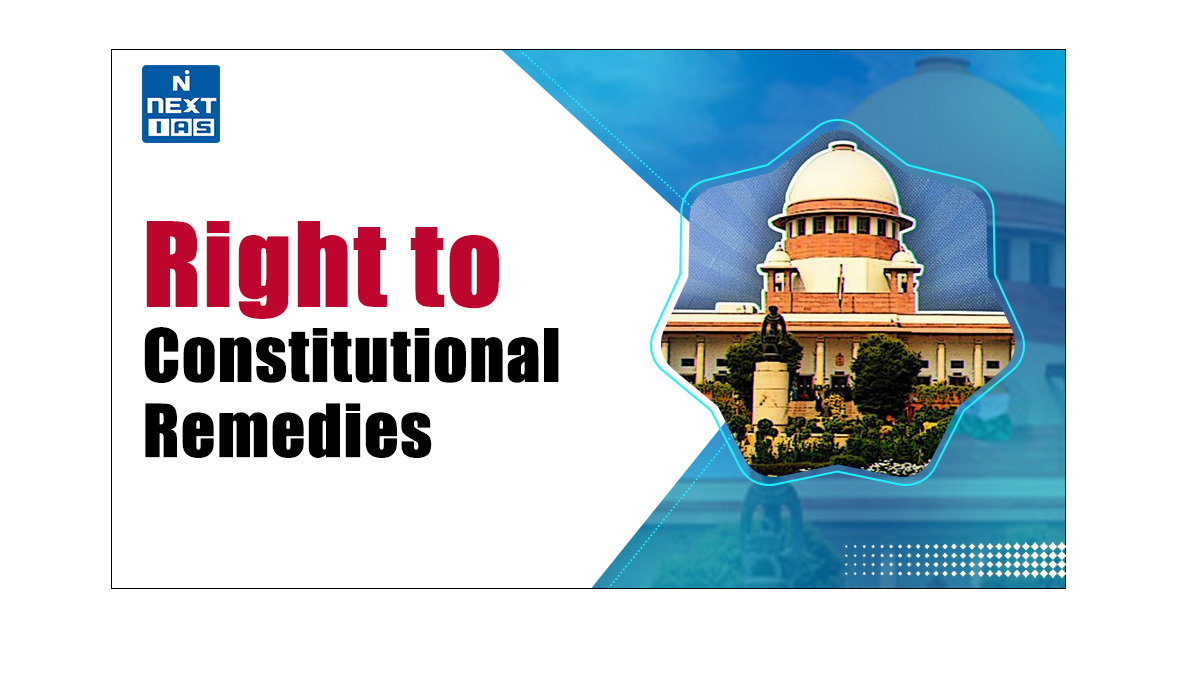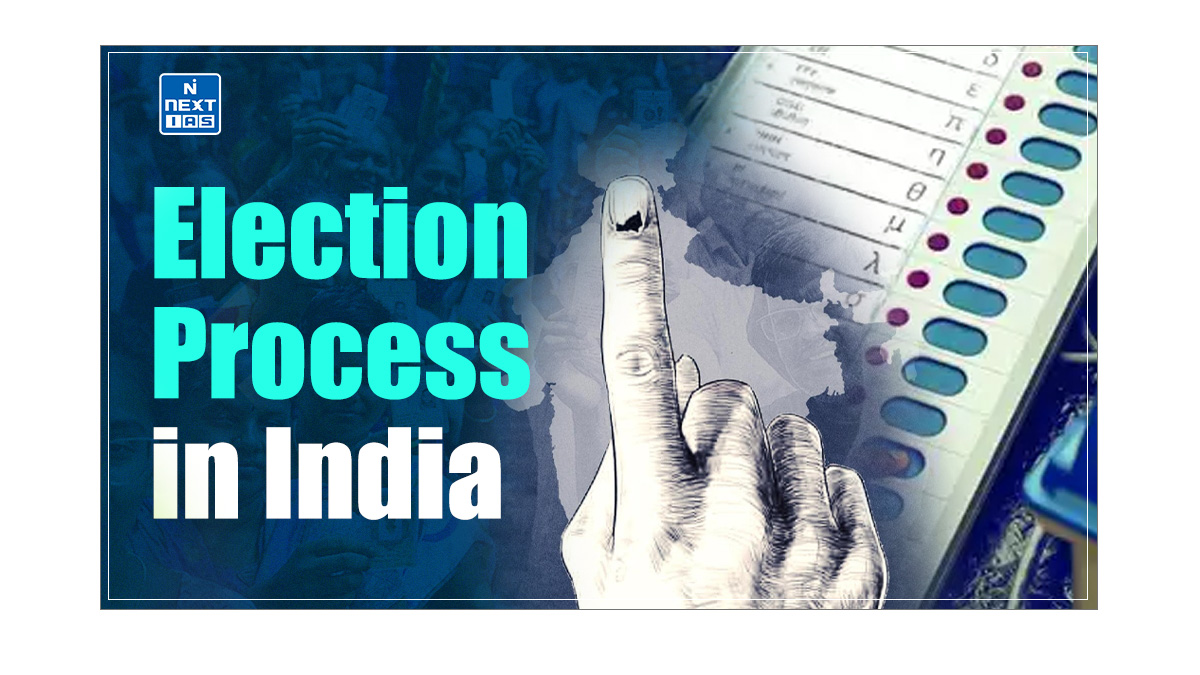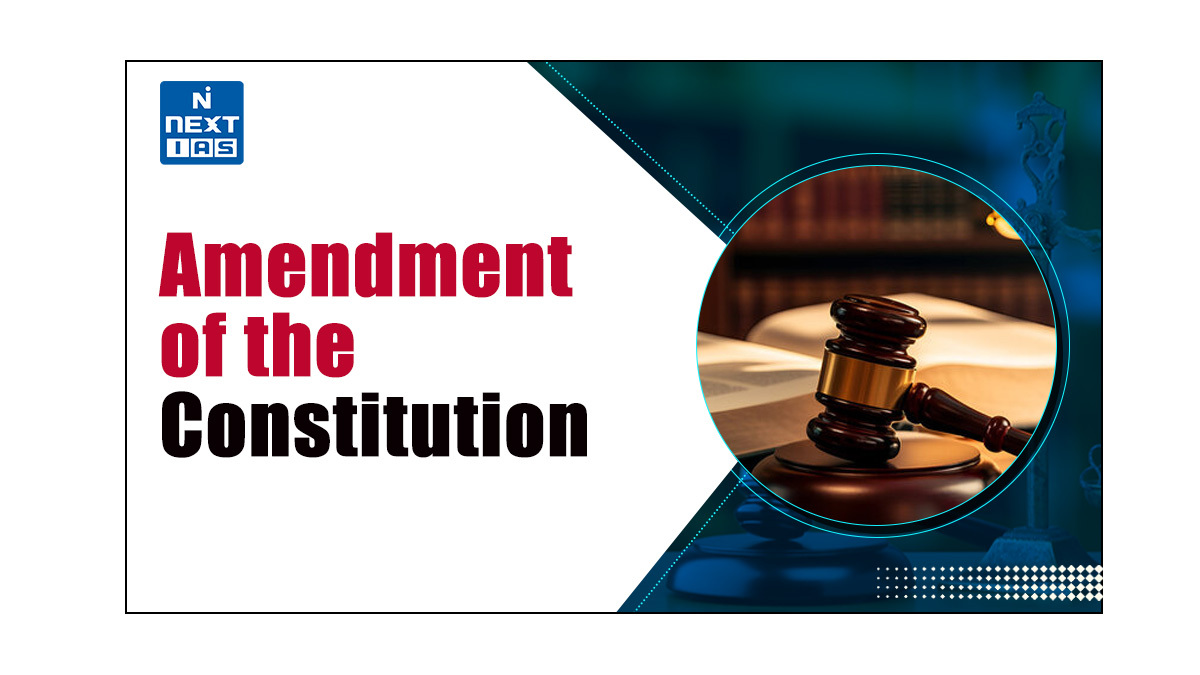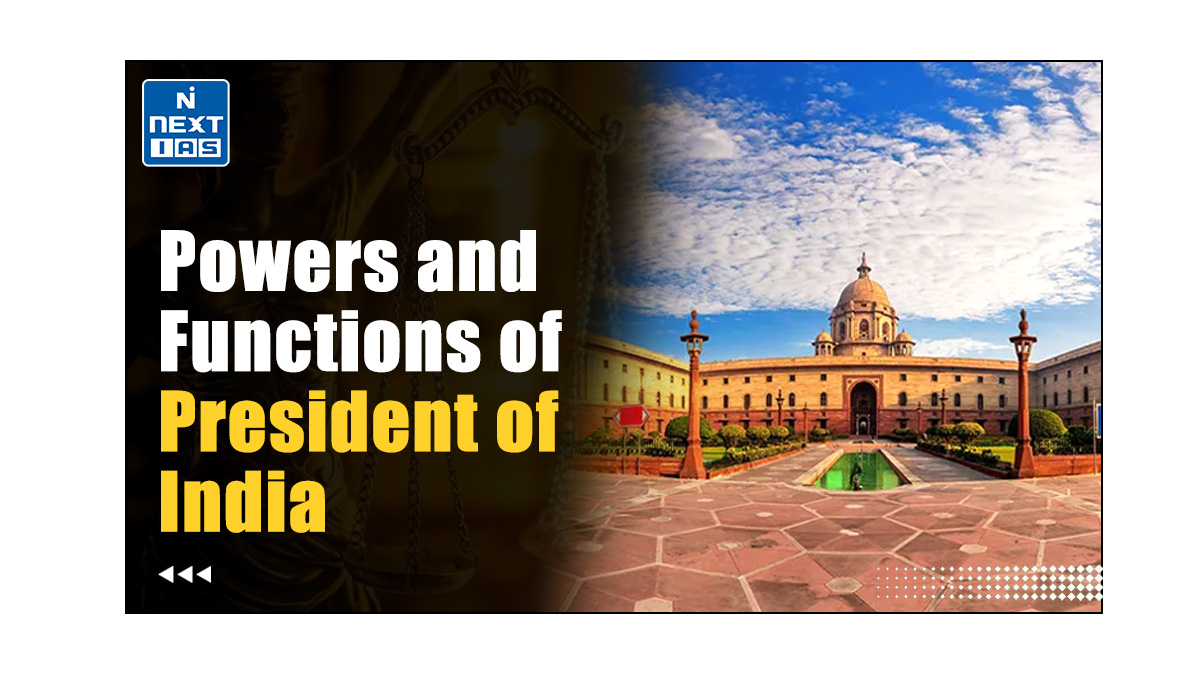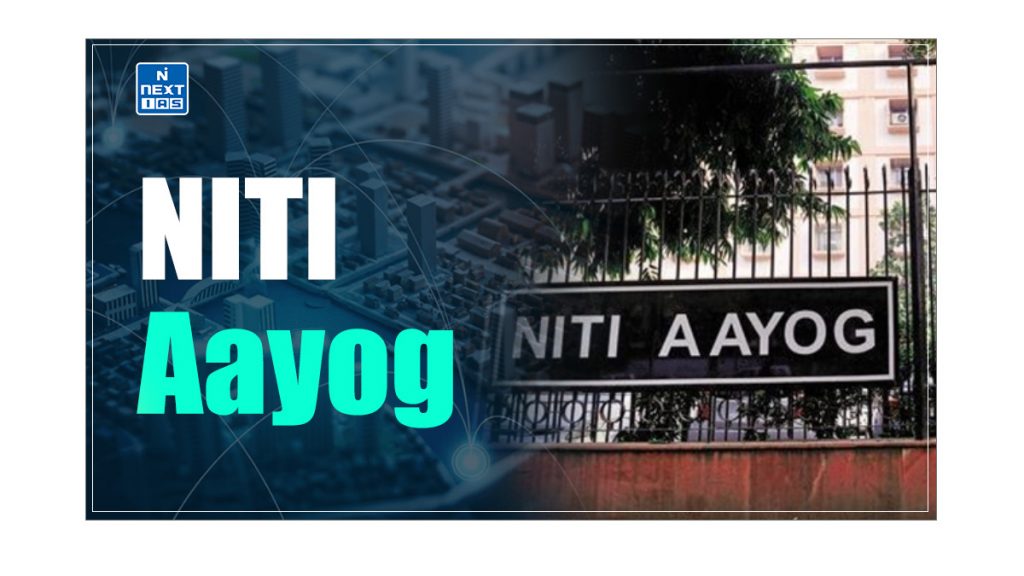
The NITI Aayog or National Institution for Transforming India stands as a pivotal institution in shaping India’s developmental vision, agenda, and strategies. Since its inception, it has played a crucial role in fostering cooperative federalism by bringing the center and states together in the nation’s growth journey. This article of NEXT IAS aims to study in detail the NITI Aayog, its establishment, composition, objectives, functions, roles, and other related aspects.
About NITI Aayog (National Institution for Transforming India)
- The NITI Aayog (National Institution for Transforming India) is the premier policy ‘Think Tank’ of the Government of India (GoI), playing a pivotal role in shaping the strategic long-term policies and programs for the country.
- NITI Aayog serves as a dynamic platform, providing both directional and policy inputs to the Government of India and offers relevant technical advice to the Centre and States.
- The Core Mission of NITI Aayog includes providing critical directional and strategic input into the development process and being the incubator of ideas for development.
Establishment of NITI Aayog
- The Government of India established the Planning Commission in March 1950 to oversee the nation’s economic strategy through centrally devised five-year plans.
- This Commission remained effective in the early years. However, over time, it started facing criticism for being too centralized & rigid, as well as for not adequately reflecting the diverse needs of India’s states and the evolving global economic landscape.
- Accordingly, the erstwhile Planning Commission was scrapped by the Central Government on August 13, 2014.
- A new body named the NITI Aayog (National Institution for Transforming India) was established on January 1, 2015, as a successor to the erstwhile Planning Commission.
- Similar to the Planning Commission, the NITI Aayog was established by an Executive Resolution of the Government of India.
- Thus, the NITI Aayog is neither a Constitutional Body (i.e. not created by the Constitution) nor a Statutory Body (i.e. not created by an Act of Parliament).
Composition of NITI Aayog
The composition of the NITI Aayog is as follows.
Chairperson of NITI Aayog
The Prime Minister of India is the ex-officio chairman of NITI Aayog.
Governing Council of NITI Aayog
The Governing Council of the NITI Aayog comprises of:
- Chief Ministers of all the States,
- Chief Ministers of the Union Territories with Legislatures (i.e. Delhi, Puducherry and Jammu and Kashmir) and
- Lt. Governors of the Union Territories without Legislatures.
Regional Councils of NITI Aayog
- Regional Councils of the NITI Aayog are formed for a specific tenure to address specific issues and contingencies impacting more than one state or region.
- The Chairperson of the NITI Aayog i.e. the Prime Minister of India convenes a Regional Council as and when needed.
- A Regional Council comprises the Chief Ministers of the States and Lt. Governors of the Union Territories (UTs) lying in a particular region.
- Regional Councils are chaired by the Chairperson of the NITI Aayog or his/her nominee.
Special Invitees to NITI Aayog
The Prime Minister of India nominates Experts, Specialists, and Practitioners with relevant domain knowledge as special invitees to the NITI Aayog.
Full-Time Organizational Framework of NITI Aayog
The Full-Time Organizational Framework of NITI Aayog is comprised of the following.
- Chairperson: The Prime Minister of India.
- Vice-Chairperson: He/she is appointed by the Prime Minister.
- He/she enjoys the rank of a Cabinet Minister.
- Full-time Members: They enjoy the rank of a Minister of State.
- Part-time Members: Maximum of 2, from leading universities, research organizations, and other relevant institutions in an ex-officio capacity.
- Part-time members are on a rotation.
- Ex-Officio Members: A maximum of 4 members of the Union Council of Ministers to be nominated by the Prime Minister.
- Chief Executive Officer: He/she is appointed by the Prime Minister for a fixed tenure, in the rank of Secretary to the Government of India.
- Secretariat: As deemed necessary.
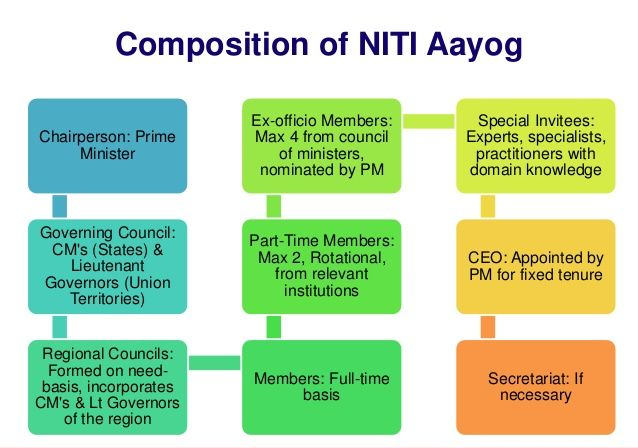
Objectives of NITI Aayog
The objectives of the NITI Aayog are as follows:
- To evolve a shared vision of national development priorities, sectors, and strategies with the active involvement of States.
- To foster cooperative federalism through structured support initiatives and mechanisms with the States on a continuous basis, recognizing that strong States make a strong nation.
- To develop mechanisms to formulate credible plans at the village level and aggregate these progressively at higher levels of government.
- To ensure, in areas that are specifically referred to it, that the interests of national security are incorporated in economic strategy and policy.
- To pay special attention to the sections of our society that may be at risk of not benefitting adequately from economic progress.
- To design strategic and long-term policy and programme frameworks and initiatives, and monitor their progress and their efficacy. The lessons learnt through monitoring and feedback will be used for making innovative improvements, including necessary mid-course corrections.
- To provide advice and encourage partnerships between key stakeholders and national and international like-minded think tanks, as well as educational and policy research institutions.
- To create a knowledge, innovation, and entrepreneurial support system through a collaborative community of national and international experts, practitioners, and other partners.
- To offer a platform for the resolution of inter-sectoral and inter-departmental issues to accelerate the implementation of the development agenda.
- To maintain a State-of-the-Art Resource Centre, be a repository of research on good governance and best practices in sustainable and equitable development as well as help their dissemination to stakeholders.
- To actively monitor and evaluate the implementation of programmes and initiatives, including the identification of the needed resources to strengthen the probability of success and scope of delivery.
- To focus on technology upgradation and capacity building for the implementation of programmes and initiatives.
- To undertake other activities as may be necessary to further the execution of the national development agenda.
Functional Framework of NITI Aayog
The functional framework of the NITI Aayog can be understood as follows.
Two Hubs of NITI Aayog
The NITI Aayog’s entire gamut of activities is divided into two main hubs:
Team India Hub
- The Team India Hub of NITI Aayog carries out the mandate of fostering cooperative federalism and designing policy and programme frameworks.
- It provides requisite coordination and support in NITI Aayog’s engagement with States.
Knowledge and Innovation Hub
The major roles of the Knowledge and Innovation Hub of NITI Aayog are as follows:
- To maintain a State-of-the-Art Resource Centre.
- To maintain a repository of research on good governance and best practices.
- To provide advice on important matters, and
- To encourage partnerships with key stakeholders, including colleges, universities, think tanks, and Non-Governmental Organizations (NGOs) at home and abroad.
Functional Verticals/Cells of NITI Aayog
- The NITI Aayog is functionally divided into various verticals/cells, which are responsible for examining and looking into sectoral issues and priorities for national development and economic growth.
- The different verticals/cells of NITI Aayog provide the requisite coordination and support framework for NITI Aayog to carry out its mandate.
- Some important functional verticals/cells of NITI Aayog include – Administration and Support Units, Agriculture and Allied Sectors, Aspirational Districts Programme Cell, etc.
Functions of NITI Aayog
The various functions performed by the NITI Aayog can be, broadly, divided into the following four main heads:
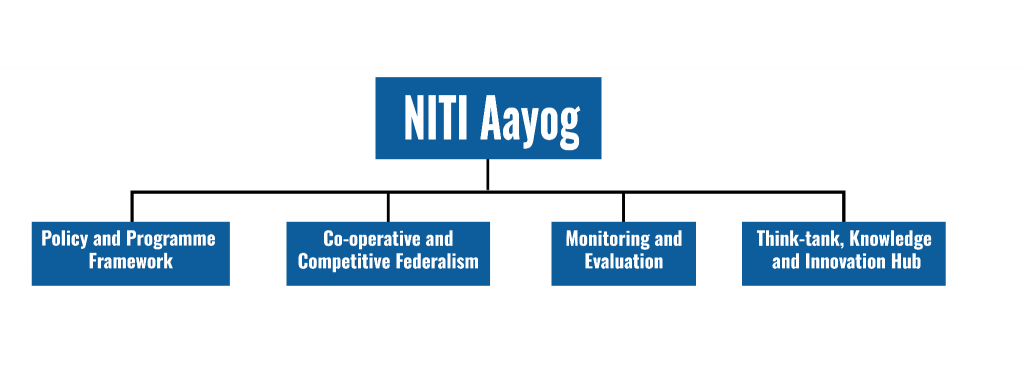
- Policy and Programme Framework – NITI Aayog provides a policy and programme framework to guide the Central and State governments in formulating and implementing policies and programmes for national and state development.
- Co-operative and Competitive Federalism – NITI Aayog promotes a spirit of cooperative and competitive federalism, where States work together and also compete to promote best practices and innovations.
- Monitoring and Evaluation – NITI Aayog closely monitors and evaluates the implementation of policies and programmes, providing feedback and recommendations to improve their effectiveness.
- Think-tank, Knowledge, and Innovation Hub – NITI Aayog functions as a think-tank, generating new ideas, knowledge, and innovations to drive India’s development agenda forward.
Guiding Principles of NITI Aayog
In carrying out its various functions, the NITI Aayog is guided by the following principles:
- Antyodaya – To prioritise service and upliftment of the poor, marginalised, and downtrodden, as enunciated in Pandit Deendayal Upadhyay’s idea of ‘Antyodaya’.
- Inclusion – To empower vulnerable and marginalised sections, redressing identity-based inequalities of all genders, regions, religions, castes or classes.
- Village – To integrate our villages into the development process, to draw on the vitality and energy of the bedrock of our ethos, culture and sustenance.
- Demographic Dividend – To harness our greatest asset – The People of India, by focussing on their development, through education and skilling, and their empowerment, through productive livelihood opportunities.
- People’s Participation – To transform the developmental process into a people-driven one, making an awakened and participative citizenry the driver of good governance.
- Governance – To nurture an open, transparent, accountable, proactive and purposeful style of governance, transitioning focus from Outlay to Output to Outcome.
- Sustainability – To maintain sustainability at the core of our planning and developmental process, building on our ancient tradition of respect for the environment.

Seven Pillars of NITI Aayog
The overall functioning of NITI Aayog is based on the following seven pillars of Effective Governance:
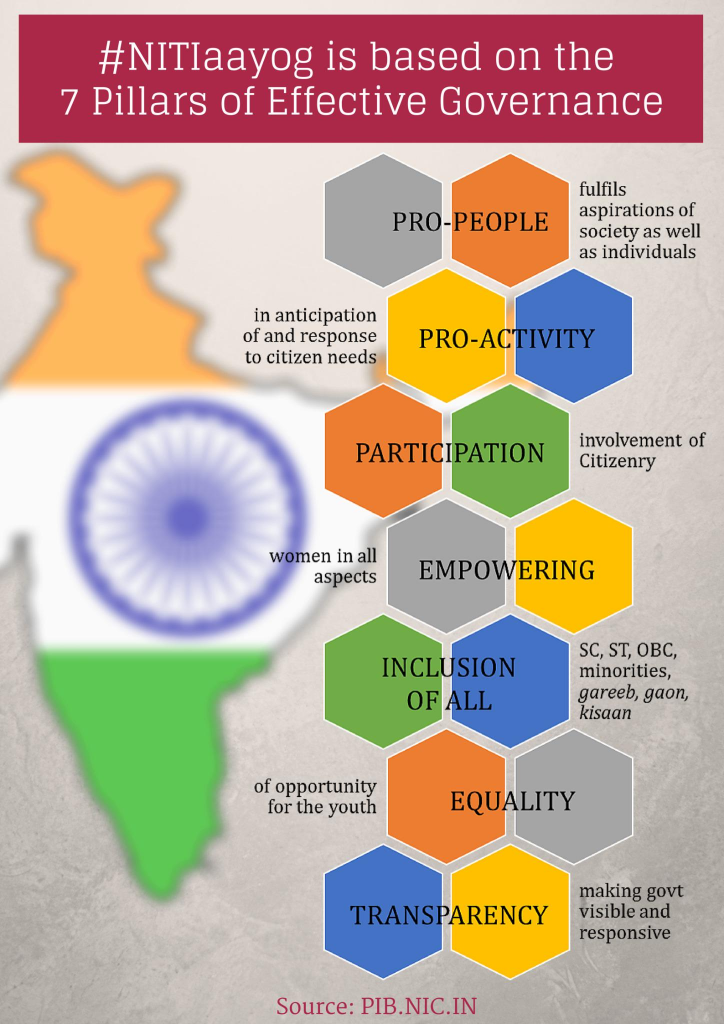
Roles and Importance of NITI Aayog
Through its various functions, NITI Aayog performs some crucial roles for the country. Its significance can be seen in terms of its roles as follows:
- Strategic and Long-term Planning – NITI Aayog focuses on long-term strategic planning rather than the traditional five-year plans. This allows the nation and the states to have a visionary approach to growth and development.
- Fostering Cooperative Federalism – By involving state governments in the decision-making process, NITI Aayog fosters Cooperative Federalism.
- This, in turn, ensures that policies are more tailored to the specific needs and circumstances of different regions along with better coordination and implementation of policies.
- Promoting Competitive Federalism – By promoting healthy competition among various units of the Indian federation, NITI Aayog promotes Competitive Federalism. This, in turn, helps in faster growth across the country.
- Policy Advisory – As per its role as the premier Think Tank, NITI Aayog acts as a policy advisor, providing expert insights and recommendations to the government on a wide range of issues, from economic reforms to social policies.
- Monitoring and Evaluation – NITI Aayog monitors the implementation of various government programs and initiatives, providing feedback and recommendations for improvement.
- Promotion of Innovation and Entrepreneurship – As one of the foremost objectives, NITI Aayog promotes innovation and entrepreneurship across the country. This, in turn, helps foster a culture of creativity and start-ups.
- Inclusive Development – Its various pillars of functioning such as enhancing citizens’ participation in governance, empowering women, etc help in ensuring inclusive development in the country.
NITI Aayog and Cooperative Federalism
- One of the foremost goals of NITI Aayog is to actualize Cooperative Federalism in India.
- Towards this goal, the NITI Aayog acts as the quintessential platform, which brings the Center as well as States together as ‘Team India’ to work towards the national development agenda.
Steps Taken by NITI Aayog to Promote Cooperative Federalism
The NITI Aayog has stated a number of initiatives to foster Cooperative Federalism in India. Some important of them can be seen as follows:
- Meetings between the Prime Minister, Cabinet Ministers and all Chief Ministers,
- Subgroups of Chief Ministers on subjects of national importance,
- Sharing of best practices,
- Policy support and capacity development of State/Union Territory functionaries,
- Launching of the Aspirational Districts Programme for the development of backward districts,
- Theme-based extensive engagements in various sectors,
- Framing model laws for land leasing and agriculture marketing reforms,
- Area-specific interventions for the North Eastern and Himalayan States and island development.
- Providing relevant technical advice to the Centre, States, and UTs.
- Establishment of models and programmes for the development of infrastructure and to reignite and establish Private-Public Partnerships (PPPs), such as the Centre-State partnership model Development Support Services to States and Union Territories (DSSS), Sustainable Action for Transforming Human Capital (SATH) program, etc.
NITI Aayog and Competitive Federalism
Along with Cooperative Federalism, NITI Aayog also endeavours to promote Competitive Federalism by facilitating the improved performance of States/Union Territories.
Steps Taken by NITI Aayog to Promote Competitive Federalism
Various efforts made by NITI Aayog towards the promotion of Competitive Federalism in India can be seen as follows:
- Providing hand-holding support to states/UTs which are lagging behind.
- Encouraging healthy competition among States through transparent rankings, in various sectors.
- Some prominent examples of indices launched by NITI Aayog include – the School Education Quality Index (SEQI), SDG Index, India Innovation Index, etc.
- Development of review mechanisms and capacity-building frameworks in close collaboration with various stakeholders.
Conclusion
In conclusion, the NITI Aayog has emerged as a dynamic and influential institution at the heart of India’s policy-making landscape. By embracing the principles of cooperative federalism, promoting competitive federalism, and functioning as a think tank and knowledge hub, the NITI Aayog has become a driving force in shaping India’s development agenda. Its unique approach, which prioritizes bottom-up planning, citizen engagement, and egalitarian access to opportunities, positions the NITI Aayog as a key player in India’s transformative journey towards a more prosperous, equitable, and sustainable future.
National Institute of Labour Economics Research and Development (NILERD)
- The National Institute of Labour Economics Research and Development (NILERD) was formerly known as the Institute of Applied Manpower Research (IAMR).
- It is a central autonomous organization under the NITI Aayog located in Narela, Delhi.
- Its primary objectives are research, data collection, education, and training in all aspects of human capital planning, human resource development, and monitoring and evaluation.
Development Monitoring and Evaluation Office (DMEO)
- The Development Monitoring and Evaluation Office (DMEO) was established by the Government in 2015 as an attached office of the NITI Aayog by merging the erstwhile Programme Evaluation Organization and the Independent Evaluation Office.
- The Headquarters of DMEO is in NITI Aayog, New Delhi.
- The primary roles of DMEO include:
- To monitor the progress and efficacy of strategic and long-term policy and program frameworks and initiatives to help innovative improvements, including necessary mid-course corrections,
- To actively monitor and evaluate the implementation of programs and initiatives, including the identification of the needed resources so as to strengthen the probability of success and scope of delivery, etc.
Differences Between NITI Aayog and the Planning Commission
| Parameters | NITI Aayog | Planning Commission |
|---|---|---|
| Role | It serves as an advisory Think Tank to the Government of India. | It served as an extra-constitutional body. |
| Expertise | It draws membership from a wider expertise. | It had limited expertise. |
| Federalism Approach | It operates in the spirit of Cooperative Federalism with States as equal partners. | The States participated as spectators in annual plan meetings. |
| Leadership | The Secretaries are known as CEOs appointed by the Prime Minister. | The Secretaries were appointed through the usual process. |
| Planning Approach | It focuses on a ‘Bottom-Up’ approach. | It focuses on a ‘Top-Down’ approach. |
| Policy Imposition | It does not possess a mandate to impose policies. | It imposed policies on States and tied allocation of funds to approved projects. |
| Fund Allocation | It does not have powers to allocate funds; this authority is vested in the Finance Minister. | It had powers to allocate funds to Ministries and State Governments. |
Comparison of Cooperative Federalism and Competitive Federalism
| Cooperative Federalism | Competitive Federalism |
|---|---|
| It emphasizes collaboration and coordination between the Central Government and State/Provincial Governments. | It emphasizes competition and decentralization of power between the Central and State/Provincial Governments. |
| It focuses on joint decision-making, shared responsibilities, and harmonized policies. | It focuses on States competing against each other to attract investments, jobs, and resources. |
| It promotes the idea of “Cooperative Competition” where States work together to achieve national goals. | It promotes the idea of “Competitive Federalism” where States compete to offer better policies, services, and incentives. |
| It encourages States to learn from each other’s best practices and innovative approaches. | It encourages States to innovate and experiment with new governance models to gain an advantage. |
| It aims to reduce conflicts and promote unity in achieving development objectives. | It can lead to disparities across States in terms of economic development and social welfare. |
Frequently Asked Questions (FAQs)
When was NITI Aayog established?
NITI Aayog was established on 1 January 2015.
What is the role of NITI Aayog?
NITI Aayog has the twin mandate to oversee the adoption and monitoring of the Sustainable Development Goals (SDGs) in the country and promote competitive and cooperative federalism among States and Union Territories (UTs).
